Long Life Tulips | FAQ
(This product is currently only available through supermarkets / retailers only.)
Below you will find a list of commonly asked questions and answers about Long Life Tulips
How do I care for Long Life Tulips
The optimal environment is a room with a lot of natural light, at room temperature. The lower the temperature (above freezing), the longer the tulips will last. Long Life Tulips tend to do really well in rooms with an average temperature of about 60F to 65F.
Even if the room is cool, avoid direct sunlight to the vase. Direct sunlight to the vase causes a “greenhouse effect” which causes the inside of the vase to heat up and reach uncomfortable levels to the bulbs ending up damaging the tulips and reducing their life-span.
It is very important not to over-water the bulbs. Roots should be kept in water and avoid dipping (splashing) the bulbs in water when moving the vase.
Can I change the water of my Long Life Tulips?
Changing the water is fine. This should be done while keeping the roots safe from damage. Hold the flowers and stems carefully while pouring out the water and refill with regular tap water.
The bulbs need to stay upright without being damaged by the plastic “needles” of the tray. It is very important not to over-water the bulbs. Roots should be kept in water and avoid dipping (splashing) the bulbs in water when moving the vase.
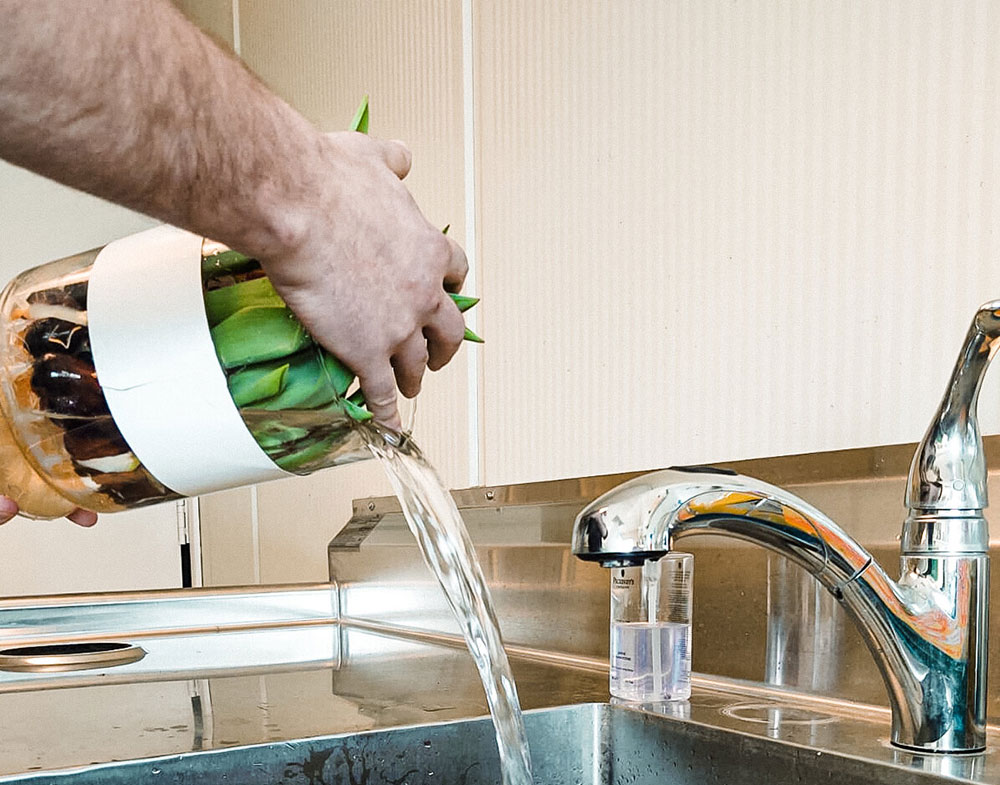
Changing water of Bloomaker’s Hydroponic Long Life Tulips
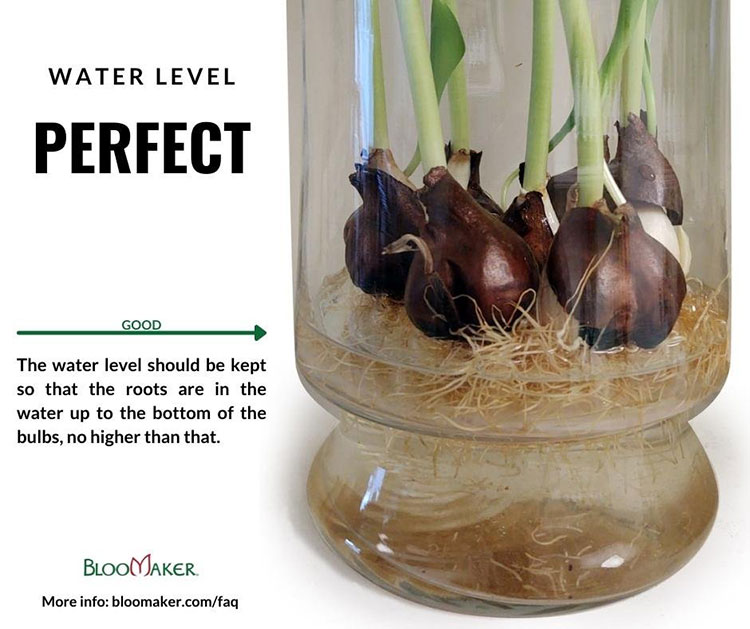
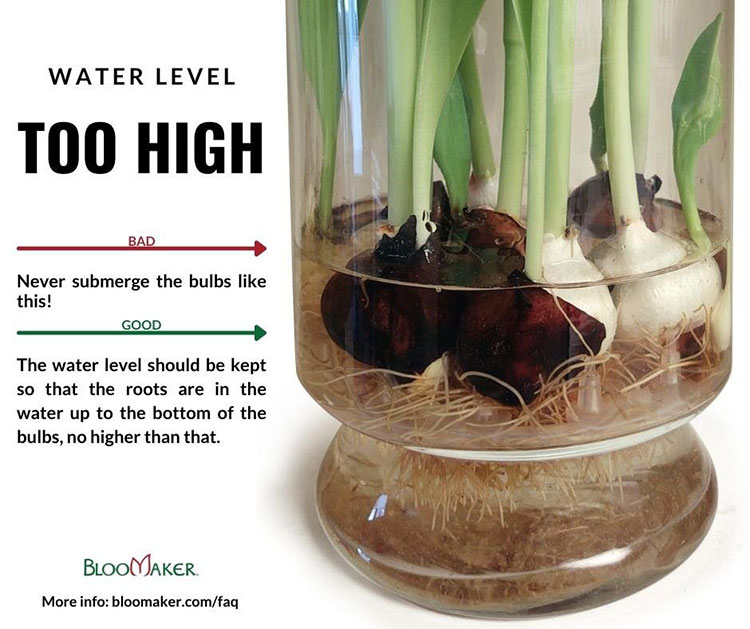
Make sure to keep the roots under water, but never to submerge the bulbs!
What is the average life span of hydroponic tulips?
We provide the flowers together with the bulb so they can live out a longer part of their life-cycle in your home.
Depending on the variety, the actual blooming period lasts about a week.In order to make the most of our flowers we recommend getting them when they are still green, that way you can enjoy more of the growing process.
The best thing you can do to help them bloom as long as possible is to keep them at a comfortable temperature between 60 and 70 degrees. Too much heat will reduce their life span. Make sure to keep the roots under water, but don’t submerge the bulbs.
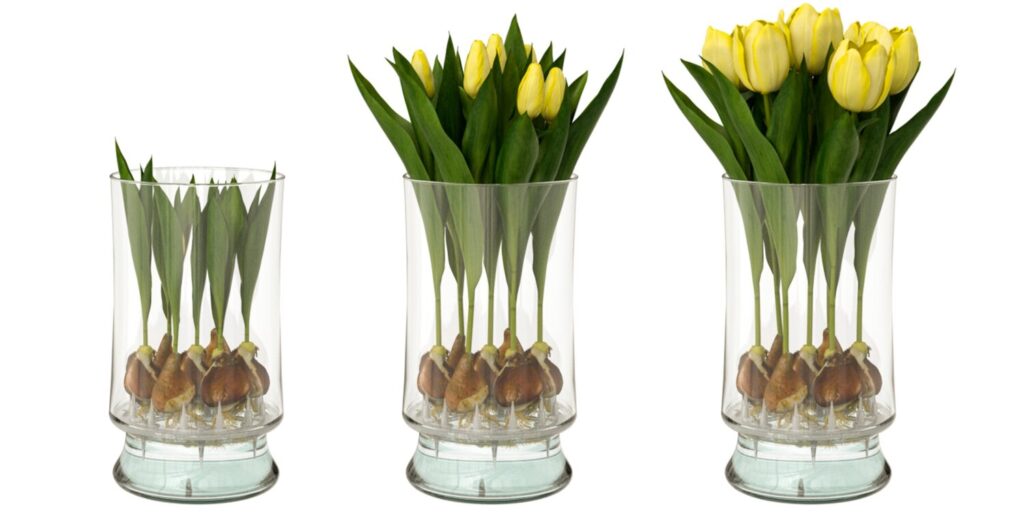
Hydroponic Long Life Tulips blooming stages
Can I order Long Life Tulip bulbs without a vase?
No. We use a time consuming process to make sure the bulbs get used to flourishing on water. We have expert growers with specialized knowledge tending to this.
We cannot ship the prepared bulbs out without the vase, because they are essential to the flowers reaching the stores healthily and undamaged.
Where can I find Long Life Tulips?
While it’s impossible for us to give you specific numbers on distribution at the store level, we can tell you which retailers we ship to in your state. Please have a look at our website here: https://www.bloomaker.com/find-us. There, we have updated information on which retailers we ship to.
We hope you can find our products in a store near you this season. If not, please let your local retailer know you’d like our products to be distributed there.
Can I regrow the tulip bulbs the vase again?
Please keep in mind that our growers use a complicated process over the course of weeks to prepare the bulbs so they can thrive hydroponically. When it comes to putting the bulbs back in the vase during the season, we cannot guarantee success.
However, after having been in the soil for the right amount of time you can try to have them live out their second life-cycle in the vase for the duration of the blooming period, but again, we cannot guarantee success. The bulbs are alive and sensitive to abrupt changes in their environment, switching them over to another is a delicate process.
What should I do after flowering?
Bloomaker does not guarantee that getting your Long Life Tulips to bloom for another year is going to work. We do however appreciate any attempt on trying to get the bulbs to rebloom. Therefore we are happy to provide you with all the information you need on the matter.
Step 1. Clip the wilted flower from the stem and then let the foliage dry completely while maintaining water level.
Step 2. When the foliage has completed drying out, you might see small new bulbs beginning to form, this is perfectly normal, please leave these.
Step 3. Cut the foliage, but leave the roots. Now it time for the bulbs to establish themselves with proper rest.
Step 4. You don’t want the bulbs to be moist when you put them in storage. Let the bulb dry thoroughly. To dry the bulbs, you can place them in a paper bag and set them somewhere that gets a lot of air circulation, near an open window or in an open garage.
When this is done, store the bulbs in a dry, cool, frost free place and away from rodents.
Step 5. Refrigerate tulips bulbs for six to eight weeks before planting in zones 8 through 10. Fruits should not be stored with the bulbs. Fruit produces ethylene gas, which destroys the flower bud within the bulb. Place them in a paper bag away from ripening fruits.
Step 6. Plant the tulip bulbs in the fall, using a good mix of soil and compost. Don’t plant the bulbs too early, or they might come up before the weather gets cold and die as soon as the weather reaches subzero temperatures.
The bulbs should be placed 6 inches deep in the soil. Do not forget to water the bulbs thoroughly at planting. The planting space should receive plenty of sunlight in well-prepared soil with fast drainage, which is essential for the proper growth. Avoid planting where water collects, or in locations that are prone to late frost.
When to plant after flowering?
Zones 4 & 5 – September or early October
Zones 6 & 7 – October to early November
Zones 8 & 9 – November to early December
Zone 10 – Late December to early January
Where can I find my planting zone?
Find your planting zone here: USDA Plant Hardiness Zone Map
There is some mold on the bulbs. What to do?
Sometimes, depending on the environment, bulbs can develop mold. This is usually due to the moist bottom of the bulb being exposed to air early on.
If there is mold, we recommend carefully rinsing the bulbs with tap water. Take care not to damage the roots. Change the water that is in the vase and repeat the next day. It is very important not to over-water the bulbs. Roots should be kept in water and try to avoid dipping (splashing) the bulbs in water when moving the vase. Keep the vase in a dry and well ventilated environment, like most living rooms.
I hope this helps answer your question.
If you think there is another problem, like damaged bulbs, we’d like to see a picture of it so our grower can take a look and see what else could have happened.
How to protect tulips from being eaten by wildlife?
Mixing with wildlife repellent flowers:
Our advise for repelling rodents and deer, is to plant tulips along with crown imperial (Fritillaria Imperialis), alliums or daffodils. However, there’s always a chance of some critter braving your defenses to get to the delicious tulips.
Tougher measures:
It’s not the prettiest, but surrounding the planting area with a mesh or some other see-through barrier will keep more out. If you try repellents, make sure to spray after each rain shower, because the repellents are scent based and get washed away.
What should I do with my Bloomaker vase?
Bloomaker vases are great for crafting. You’ll find some great photos that have been sent to us in our Gallery.
Made something already? Share your creation with us. We might feature your photo on our website.
Share your photos on Instagram & Facebook or by using the hashtag #bloomaker and tagging us @bloomaker
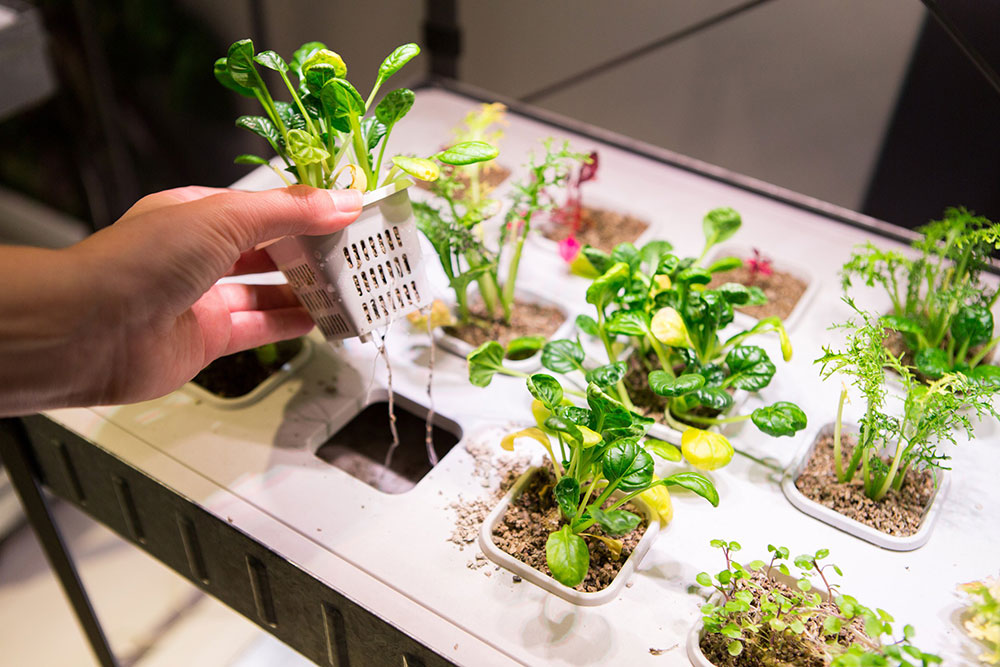
I cannot find my question. How do I proceed?
If the answer to your question is not on the FAQ pages, click the chat icon in the right bottom corner of the page and type your question.
